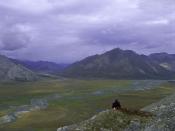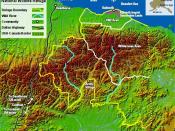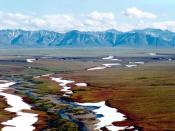Due to high oil prices and foreign oil concerns, the United States has been provoked to look elsewhere for oil. One possible supply of domestic oil presents itself in Alaska, and the United States Congress has questioned if they should drill into the Area 1002 sector of the Arctic National Wildlife Refuge. If Congress decides to drill into this controversial area, much of the fragile and sensitive ecosystems will be destroyed.
First and foremost, the six ecosystems present in this refuge make it the most diverse in the circumpolar arctic. If the United States Congress allows oil drilling in the refuge, many of these ecosystems will be destroyed, and possibly lead to the extinction of many threatened arctic animals. The northernmost boundaries of the refuge are composed of barrier islands, coastal lagoons, salt marshes, and river deltas. These ecosystems are inhabited by numerous migratory waterfowl, such as sea ducks, geese, swans, and shorebirds.
Many fish also inhabit the coastal shoreline, such as dolly varden, and arctic cisco. In addition, bountiful amounts of caribou line the coastal land, and polar bears use the frigid icebergs in the sea to hunt seals. Polar bears also trek their way back to the coastal plain, every winter, to nurse their young in snow dens. The mountains of the Brooks Range, the northernmost portion of the Rocky Mountains, possess important tundra zones. The Brooks Range is south of the coastal plain, and its landscape is composed of dense shrubs, northern poplar tree groves, and spruce on the south. During the summer months, many birds of prey nest on the cliffs. These birds include peregrine falcons, gyrfalcons, and golden eagles. In the valleys between mountains, rivers are inhabited by Harlequin ducks, and red-breasted mergansers. Permanent residents of the refuge include the Dall sheep, wolves, grizzly...


